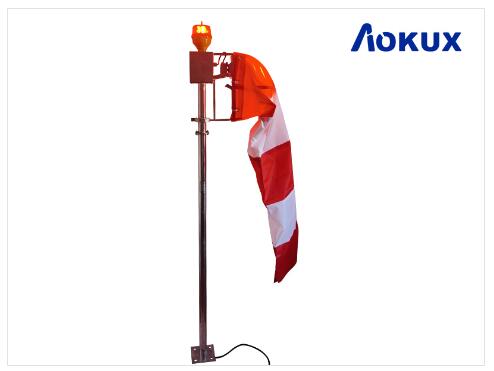
Helipad windsocks are a critical component in the aviation industry, especially for helicopter operations. These simple yet effective devices provide essential information about wind direction and speed, which are crucial for safe takeoffs and landings. This article explores the significance, types, installation guidelines, regulatory frameworks, and technological advancements associated with helipad windsocks.
The Significance of Helipad Windsocks
Helipad windsocks play a vital role in helicopter operations for several reasons:
Wind Direction Indication: Helicopter pilots rely on accurate wind direction information for safe takeoffs and landings. Windsocks provide a visual indication of the wind direction, allowing pilots to align their approach and departure to minimize crosswind impacts and ensure safety.
Wind Speed Estimation: The angle and movement of the windsock can give pilots a rough estimate of the wind speed. This information helps pilots make informed decisions about whether it is safe to proceed with landing or takeoff under the current wind conditions.
Safety and Efficiency: Proper use of windsocks enhances the overall safety and efficiency of helicopter operations. By providing real-time wind information, windsocks help in reducing the risk of accidents caused by unexpected wind changes, thus improving operational efficiency.
Compliance with Regulations: Aviation authorities mandate the use of windsocks on helipads to ensure that pilots have the necessary wind information. Compliance with these regulations is essential for maintaining operational licenses and avoiding penalties.
Types of Helipad Windsocks
Helipad windsocks come in various types and configurations to meet different operational needs and environmental conditions. The primary types include:
Standard Windsocks: These are the most common type of windsocks used on helipads. They are made of durable fabric and are designed to be highly visible, typically in bright colors such as orange or white with contrasting stripes. Standard windsocks are mounted on a pole and freely rotate to indicate wind direction.
Lighted Windsocks: For helipads that operate at night or in low-visibility conditions, lighted windsocks are essential. These windsocks are equipped with internal or external lighting to ensure they remain visible to pilots at all times. LED lighting is commonly used due to its energy efficiency and longevity.
Framed Windsocks: In areas with fluctuating wind conditions or where a more stable indication is required, framed windsocks are used. These windsocks are supported by a frame that keeps them open even in light winds, providing a consistent indication of wind direction and speed.
Telescoping Windsocks: These windsocks are mounted on telescoping poles that can be adjusted in height. They are particularly useful for temporary or portable helipad setups, allowing for quick deployment and adjustment to optimal viewing height.
Installation Guidelines
Proper installation of helipad windsocks is crucial for their effective operation. Key guidelines include:
Location: Windsocks should be installed in a location that is easily visible from all approach paths to the helipad. They should be placed away from obstructions such as buildings or trees that could disrupt wind flow and affect the accuracy of the wind indication.
Height: The height of the windsock pole should be sufficient to ensure it is visible from the cockpit of an approaching helicopter. Typically, windsock poles are installed at a height of 10 to 15 feet.
Visibility: The windsock should be made of bright, contrasting colors to ensure maximum visibility. Reflective materials or additional lighting may be used to enhance visibility during nighttime or low-light conditions.
Maintenance: Regular maintenance is essential to ensure the windsock remains in good condition and provides accurate wind information. This includes checking for tears or wear in the fabric, ensuring the pole and swivel mechanism are functioning correctly, and replacing the windsock as needed.
Regulatory Frameworks
The use of windsocks on helipads is governed by strict regulations set by aviation authorities to ensure safety and compliance. Key regulatory bodies and their guidelines include:
Federal Aviation Administration (FAA): In the United States, the FAA mandates the use of windsocks on all licensed helipads. The FAA Advisory Circular AC 150/5345-27F provides detailed guidelines on the design, installation, and maintenance of windsocks to ensure they meet the necessary standards for visibility and durability.
International Civil Aviation Organization (ICAO): ICAO sets international standards for aviation safety, including the use of windsocks on helipads. ICAO Annex 14 to the Convention on International Civil Aviation outlines the requirements for windsock installation and maintenance to ensure consistent and reliable wind indication worldwide.
European Aviation Safety Agency (EASA): In Europe, EASA regulates aviation safety, including the use of windsocks on helipads. EASA’s regulations align with ICAO standards to ensure consistency and compliance across member states.
Civil Aviation Authorities (CAA): Many countries have their own civil aviation authorities that enforce regulations similar to those of the FAA and ICAO. For instance, the UK CAA has specific guidelines for the use of windsocks on helipads to ensure air navigation safety.

Technological Advancements
Technological advancements have significantly enhanced the functionality and reliability of helipad windsocks. Key innovations include:
LED Lighting: The adoption of LED lighting in windsocks has improved visibility and energy efficiency. LEDs offer a longer lifespan and require less maintenance compared to traditional lighting options, making them ideal for lighted windsocks.
Durable Materials: Advances in fabric technology have led to the development of more durable and weather-resistant windsocks. These materials can withstand harsh environmental conditions, reducing the need for frequent replacements and ensuring consistent performance.
|
helipad windsock |
helipad windsock |
| 12 | 34 |
| 56 | 78 |